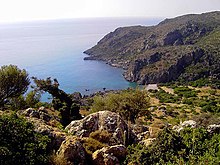
Back Lissos BAR Lissos Catalan Lissos CEB Lissos Czech Lisos (Kreta) German Λισσός Greek Liso (Creta) Spanish Lissos (Kreeta) Finnish Lissós Portuguese Lissos (fornlämning i Grekland) Swedish

Lissus or Lissos (Ancient Greek: Λίσσος)[1] was a town on the south coast of ancient Crete, which the anonymous Stadiasmus Maris Magni places between Syia and Calamyde.[2] The Peutinger Table gives 16 M.P. as the distance between Cantanum and Lissus (there recorded as Liso). It was one of the harbours (the other was Syia) of Elyrus. It was established in the Classical period and flourished until the Late Antiquity. Its name was made certain by inscriptions. The early history of the city is unknown. Based on inscriptions and coins of the 3rd century BCE, we know the city allied with King Magas of Cyrene, and joined the League of Oreians. The koinon of the Oreians consisted of the cities Lissus, Syia, Poikilassos, Tarrha, Yrtakina and Elyrus. Lissus had powerful trading and fishing fleets.
This Cretan city was an episcopal see in the time of Hierocles.[3] The order in which Flaminius Cornelius mentions it with the other bishoprics in the west part of the island agrees very well with its actual location in Agios Kirikos area, near the small village of Sougia, 70 km south of Chania.[4][5]
Of all the towns which existed on this part of the coast, Lissus alone seems to have struck coins, a fact which agrees very well with the evidence supplied by its situation, of its having been a place of some trading importance. The harbour is mentioned in the Periplus of Pseudo-Scylax, and the types of the coins are either maritime, or indicative of the worship of Dictynna, as might have been expected on this part of the island. The obverse of one coin bears the impress of the caps and stars of the Dioscuri, and its reverse a quiver and arrow. On the second coin the caps and stars are replaced by a dolphin, and instead of the quiver a female head, probably that of Artemis or Dictynna.[6] Lissus and Yrtakina were allies, and they had trading intercourse with common currency. Their coins had a dolphin or flying dove on the one side, and eight-ray star with the word L/I/S/I/O/N (of the Lisians) on the other.
- ^ Ptolemy. The Geography. Vol. 3.17.3.
- ^ Stadiasmus Maris Magni
- ^ Comp. Cornel. Creta Sacra, vol. i. p. 235.
- ^ Richard Talbert, ed. (2000). Barrington Atlas of the Greek and Roman World. Princeton University Press. p. 60, and directory notes accompanying. ISBN 978-0-691-03169-9.
- ^ Lund University. Digital Atlas of the Roman Empire.
- ^ Comp. Joseph Hilarius Eckhel, Doctrina numorum veterum, vol. ii. p. 315.
© MMXXIII Rich X Search. We shall prevail. All rights reserved. Rich X Search